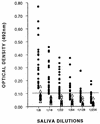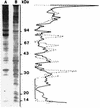Secretory immune response to membrane antigens during Giardia lamblia infection in humans
- PMID: 9453637
- PMCID: PMC107966
- DOI: 10.1128/IAI.66.2.756-759.1998
Secretory immune response to membrane antigens during Giardia lamblia infection in humans
Abstract
The secretory immune response in humans infected with Giardia lamblia was studied by using saliva samples and a membrane-rich protein fraction. The membrane fraction, studied by sodium dodecyl sulfate-polyacrylamide gel electrophoresis, showed 24 antigen bands, ranging from 170 to 14 kDa. Saliva samples from giardiasis patients showed a heterogeneous response against the membrane fraction when they were assayed by immunoblotting. Among the antigens recognized by patient saliva samples, those of 170, 105, 92, 66, 32, 29, and 14 kDa stood out. These antigens were not recognized by saliva samples from healthy individuals. They may be of importance in future studies of protection from or diagnosis of G. lamblia infections.
Figures





References
-
- Akerlund A S, Hanson L A, Ahlstedt S, Carlsson B. A sensitive method for specific quantitation of secretory IgA. Scand J Immunol. 1977;6:1275–1282. - PubMed
-
- Bradford M M. A rapid and sensitive method for the quantitation of microgram quantities of protein utilizing the principle of protein-dye binding. Anal Biochem. 1976;72:248–254. - PubMed
-
- Char S, Shetty N, Narasimha M, Elliot E, Macaden R, Farthing M J G. Serum antibody response in children with Giardia lamblia infection and identification of an immunodominant 57-kilodalton antigen. Parasite Immunol. 1991;13:329–337. - PubMed
-
- Del Muro R, Acosta E, Merino E, Glender W, Ortiz-Ortiz L. Diagnosis of intestinal amebiasis using salivary IgA antibody detection. J Infect Dis. 1990;162:1360–1364. - PubMed
-
- Farthing M J G. Host-parasite interactions in human giardiasis. Q J Med. 1989;70:191–204. - PubMed
Publication types
MeSH terms
Substances
LinkOut - more resources
Full Text Sources
Medical

